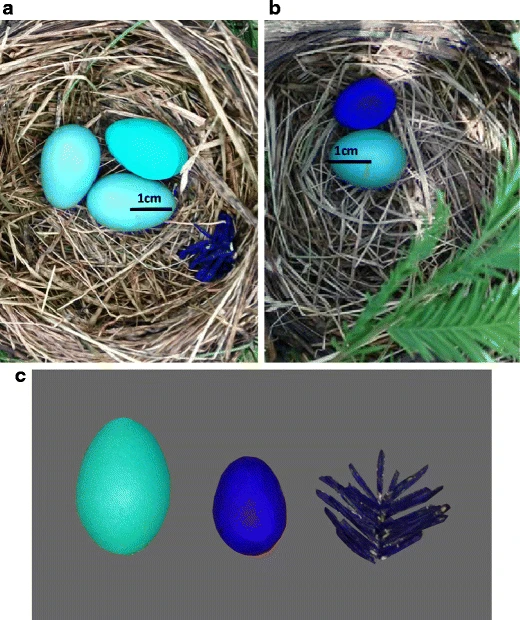 3D printed eggs and fir leaves used in experiments
3D printed eggs and fir leaves used in experiments
A test of the nest sanitation hypothesis for the evolution of foreign egg rejection in an avian brood parasite rejecter host species
Abstract
Hosts of avian brood parasites have evolved diverse defenses to avoid the costs associated with raising brood parasite nestlings. In egg ejection, the host recognizes and removes foreign eggs laid in its nest. Nest sanitation, a behavior similar in motor pattern to egg ejection, has been proposed repeatedly as a potential pre-adaptation to egg ejection. Here, we separately placed blue 3D-printed, brown-headed cowbird (Molothrus ater) eggs known to elicit interindividual variation in ejection responses and semi-natural leaves into American robins’ (Turdus migratorius) nests to test proximate predictions that (1) rejecter hosts should sanitize debris from nests more frequently and consistently than accepter hosts and (2) hosts that sanitize their nests of debris prior to the presentation of a foreign egg will be more likely to eject the foreign egg. Egg ejection responses were highly repeatable within individuals yet variable between them, but were not influenced by prior exposure to debris, nor related to sanitation tendencies as a whole, because nearly all individuals sanitized their nests. Additionally, we collected published data for eight different host species to test for a potential positive correlation between sanitation and egg ejection. We found no significant correlation between nest sanitation and egg ejection rates; however, our comparative analysis was limited to a sample size of 8, and we advise that more data from additional species are necessary to properly address interspecific tests of the pre-adaptation hypothesis. In lack of support for the nest sanitation hypothesis, our study suggests that, within individuals, foreign egg ejection is distinct from nest sanitation tendencies, and sanitation and foreign egg ejection may not correlate across species.